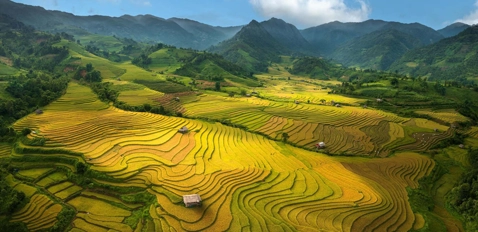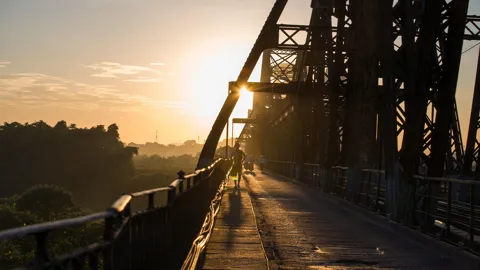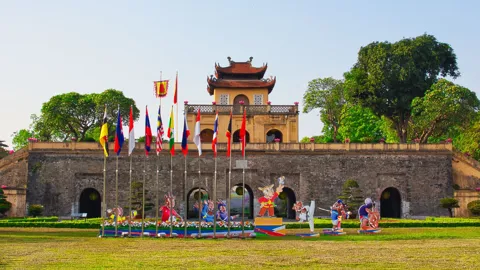Thay Pagoda: An Artistic Treasure Of Architecture In The Heart Of Hanoi
For generations, Thay Pagoda has been a revered spiritual destination for the people of Hanoi in particular and Vietnamese from across the country in general. Its poetic landscape of mountains and water, combined with a unique architectural style deeply rooted in religious and historical values, has long captured the hearts of visitors. Let Vietnam Original Travel guide you on a journey to explore this remarkable temple.
A Glimpse At Thay Pagoda
Thay Pagoda, formally known as Thien Phuc Tu, is one of the oldest and most renowned temples in Hanoi. Located at the foot of Sai Son Mountain in Sai Son Commune, Quoc Oai District, the pagoda lies about 20 kilometers southwest of the city center. It has long been a popular spiritual destination, attracting pilgrims and visitors from across the country.
Historical Background
Thay Pagoda was founded in the 11th century during the flourishing Ly Dynasty, a period known for the strong development of Buddhism in Vietnam. Originally constructed as a peaceful sanctuary for worship and meditation, the pagoda has long been a spiritual anchor for the local community and a symbol of religious devotion that has endured through generations.
The temple is most famously associated with Zen Master Tu Dao Hanh, a legendary monk known for his spiritual powers, healing abilities, and contributions to Vietnamese culture. He is believed to have created traditional water puppetry—a unique art form that was first performed on the lotus pond in front of the pagoda. Through its deep religious roots and cultural significance, Thay Pagoda continues to embody the spiritual and artistic heritage of Vietnam.
Architectural Highlights
Thay Pagoda is not only revered for its spiritual significance but also admired for its harmonious architecture nestled within a breathtaking natural setting. The entire complex is a beautiful representation of traditional Vietnamese temple design, with symbolic elements that reflect Buddhist philosophy and local craftsmanship.
Long Tri Lake-Thuy Dinh
At the beginning of your journey to Thay Pagoda, you’ll be greeted by a peaceful lake with gentle ripples dancing across its clear surface. In the center stands an ancient pavilion known as the Thuy Dinh, built in a distinctive architectural style. This structure serves as the stage for traditional water puppet performances held during the annual Thay Pagoda Festival. The spacious lake, located right in front of the main temple, is named Long Tri, also known as Long Chieu, which translates to “Dragon Pond”—a name that reflects both its grandeur and spiritual symbolism.
Thay Pagoda Complex
After crossing Long Tri Lake, visitors arrive at the main Thay Pagoda complex, which is built in the traditional “Tam” layout—a symbolic architectural style featuring three parallel halls: Ha Pagoda (Lower Hall), Trung Pagoda (Middle Hall), and Thuong Pagoda (Upper Hall).
Ha Pagoda serves as the space for Buddhist monks and followers to gather, pray, and recite scriptures.
Trung Pagoda is dedicated to the Three Jewels (Tam Bao), housing altars for the Buddha, the Dharma Protectors, and Heavenly Kings.
Thuong Pagoda, located at the highest level, enshrines statues of Zen Master Tu Dao Hanh in three reincarnations, along with the Amitabha Trinity and the historical Buddha Shakyamuni.
Flanking both sides of the central structure are statues of 18 Arhats (La Han), standing solemnly to guard and bless the sacred grounds.
Nhat Tien And Nguyet Tien Bridges
The two bridges were built in the unique architectural style of “upper house, lower bridge” (thuong gia, ha kieu), where a small wooden pavilion rests atop an arched stone base. Nguyet Tien Bridge, located to the right of the main pagoda, connects the lakeside path to the mountain trail. On the opposite side, Nhat Tien Bridge leads to a small islet where the Temple of the Three Palaces (Tam Phu) is situated. According to legend, both bridges were constructed in the early 17th century under the design and guidance of the renowned scholar-official Phung Khac Khoan, also known as Trang Bung.
Tam Phu Temple
The temple stands on a raised islet in the middle of Long Tri Lake. Measuring 5 meters wide and 7 meters long, it consists of three main chambers and two small side compartments. The structure is built from dark red laterite stone, with four sloping roofs covered in traditional “shoe-shaped” tiles. Its architecture follows the “stacked beams and extended eaves” (chong ruong bay hien) style. Tam Phu Temple was constructed in the early Nguyen Dynasty.
Cao Pagoda
From the main Thay Pagoda complex, visitors can follow a stone-paved path leading uphill through lush greenery to reach Cao Pagoda (also known as Upper Pagoda). Perched halfway up Sai Son Mountain, this tranquil temple offers sweeping views of the surrounding countryside and serves as a serene space for quiet reflection and spiritual retreat. According to legend, this is where Zen Master Tu Dao Hanh practiced asceticism and attained enlightenment.
Cac Co Cave
Nearby lies the mysterious Cac Co Cave, a small cavern steeped in history. The name “Cac Co” loosely translates to “where the female martyrs lie,” referring to a tale of loyal palace maidens who ended their lives here in protest against corruption and injustice. The cave holds a solemn and contemplative atmosphere, drawing visitors who wish to pay silent tribute to their sacrifice.
Spiritual And Cultural Experiences
Worship Activities & Sacred Ambience
Visitors are immersed in a peaceful, spiritual atmosphere as they explore the pagoda. Devotees and pilgrims often engage in incense offerings, silent prayers, and Buddhist rituals—creating a sense of serenity and reverence throughout the site.
Thay Pagoda Festival (Third lunar month)
Held annually in the third month of the lunar calendar, the Thay Pagoda Festival is one of the most important spiritual events in the region. It features ceremonial processions, folk games, and performances, attracting both locals and travelers seeking cultural enrichment.
Tu Dao Hanh—The Legendary Monk
The pagoda is dedicated to Zen master Tu Dao Hanh, a legendary figure known for his spiritual teachings and mystical abilities. His presence is deeply felt across the temple grounds, especially in the stories, statues, and rituals honoring his life.
Traditional Water Puppetry
Thay Pagoda is also known as the birthplace of water puppetry—a traditional Vietnamese art form believed to be founded by Tu Dao Hanh. Performances are often held during festivals, with puppets dancing gracefully over water to the rhythm of folk music.
Scenic Surroundings and Hiking
Beyond its spiritual and architectural allure, the area around Thay Pagoda offers nature enthusiasts a wealth of scenic adventures.
Sai Son Mountain and Cave Exploration: Venture onto the trails of Sai Son Mountain, where winding paths lead to hidden caves and rocky alcoves. These natural formations invite explorers to delve into the region’s mysterious past and offer a refreshing break from the bustling temple grounds.
Panoramic Views from Higher Elevations: As you ascend the gentle slopes, you’ll be rewarded with breathtaking panoramic vistas of the lush Vietnamese countryside and the distant cityscape. The higher vantage points are perfect for capturing stunning photographs and enjoying moments of quiet reflection.
Quiet Rural Landscapes Nearby: Surrounding the pagoda, the serene rural environment—with its expansive greenery and gentle fields—further enhances the tranquil experience. This peaceful setting not only complements the spiritual ambiance but also provides a perfect retreat for those looking to reconnect with nature.
Travel Tips For Visiting Thay Pagoda
Best Time To Visit
The most vibrant time to visit is during the Thay Pagoda Festival, which takes place in March (lunar calendar). This is when traditional rituals, water puppet performances, and local festivities bring the site to life. However, for a quieter, more meditative experience, consider visiting on weekdays between February and April when the weather is pleasant, and the spring landscape is at its best.
How To Get There From Hanoi
Thay Pagoda is located about 20 km southwest of Hanoi, in Sai Son commune, Quoc Oai district. The easiest way to get there is by motorbike, taxi, or private car, which takes about 40–50 minutes. There are also local buses that run from My Dinh or Yen Nghia bus stations to Quoc Oai, though you’ll need to take a short taxi ride from there to reach the pagoda.
Entrance Fees And What To Prepare
The entrance fee is usually modest, around 10,000–30,000 VND, depending on the time of year and activities. Be sure to wear respectful clothing (covering shoulders and knees), bring comfortable shoes for walking and climbing, and prepare some cash for offerings or souvenirs. A small flashlight may be helpful if you plan to explore the caves.
Who It’s Suitable For
Thay Pagoda is a great destination for families, solo travelers, photographers, and especially spiritual seekers looking for a tranquil escape. The combination of nature, culture, and history makes it appealing to a wide range of visitors—from pilgrims to casual tourists.
Nearby Attractions To Combine
If you’re planning a day trip or weekend getaway, Thay Pagoda can easily be combined with several other notable destinations nearby:
Tay Phuong Pagoda: Just a short drive away, this ancient pagoda is famous for its remarkable collection of wooden Buddha statues and intricate architecture. Built on a hill, it offers a peaceful atmosphere and scenic views, making it a perfect spiritual and cultural complement to Thay Pagoda.
Duong Lam Ancient Village: About 20 km from Thay Pagoda, Duong Lam is one of Vietnam’s best-preserved traditional villages. Wander through its laterite brick lanes, explore old houses dating back hundreds of years, and experience authentic Vietnamese rural life.
Ba Vi National Park or Khoang Xanh–Suoi Tien Resort: For nature lovers, Ba Vi National Park offers lush forests, cool mountain air, and hiking trails that lead to French ruins and panoramic viewpoints. Alternatively, Khoang Xanh–Suoi Tien Resort provides relaxing hot springs and water parks—ideal for families or travelers seeking both fun and relaxation.
These destinations are all within a 30–60-minute drive from Thay Pagoda, making it easy to create a rich and varied itinerary in western Hanoi.
Thay Pagoda: A Peaceful Retreat In Hanoi
Thay Pagoda is a sacred ancient temple located near Hanoi. If you have the chance to visit the capital, don’t miss the opportunity to explore this peaceful site, admire its serene surroundings, and experience the tranquil atmosphere of a spiritual retreat. More than just a religious destination, Thay Pagoda holds significant cultural and historical value, with its unique traditional architecture promising a memorable experience on your journey through Hanoi’s outskirts.
>>> Tay Phuong Pagoda: Where Silence Speaks And The Soul Finds Peace
Send us your comments about : Thay Pagoda: An Artistic Treasure Of Architecture In The Heart Of Hanoi
Required fields *
You might also be interested
Travel ideas
Need some inspiration? Discover some of the best tours in Vietnam, which are highly appreciated by our clients. An excellent starting point to help you choose the right trip to Vietnam, Laos, Cambodia, Burma or Thailand, whether you are traveling alone, as a couple, as a family or with friends.
And because this trip is yours, feel free to customize it as you wish!
Vietnam Cambodia Itinerary 14 Days
Hanoi – Hoa Binh – Mai Chau – Ninh Binh – Halong bay – Hue - Danang – Hoian – Saigon – Ben Tre - Can Tho – Saigon - Siem Reap Angkor - Tonlé Sap - Siem Reap – Ta Prohm - Departure
Vietnam 14 Day Itinerary
Vietnam 14-day itinerary covers the country’s top highlights and quintessential experiences for an unforgettable journey.
Honeymoon Tour Packages In Vietnam 12 Days
Saigon Arrival - City Tour – Mekong Delta – Danang – Hoian - by flight - Da Nang – Hanoi - by flight – Halong - overnight on junk – Departure
Authentic Hoang Su Phi Trekking Tours
Hoang Su Phi trekking tours take you to stunning terraces, meet few tourists, connect with locals and enjoy authentic culture.
Best Nha Trang Beach Tour 4 Days
Saigon/Hanoi – Nha Trang relaxation – Saigon/Hanoi – Departure
Mekong Delta Bike Tour Itinerary 7 Days
Cycle through the Mekong Delta in 7 days, discovering floating markets, orchards, craft villages, and tranquil green islands.
Are you interested in this tour?






































Comment